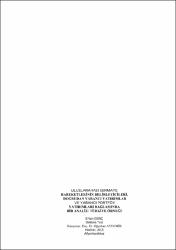Uluslararası Sermaye Hareketlerinin Belirleyicileri, Doğrudan Yabancı Yatırımlar Ve Yabancı Portföy Yatırımları Bağlamında Bir Analiz: Türkiye Örneği
Abstract
Bu çalışmanın amacı 1989 yılında sınırlarını uluslararası sermaye hareketlerine açmış olan Türkiye’ ye giriş yapan uluslararası sermayenin temel makroekonomik belirleyicilerini tespit etmek ve bu temel makroekonomik değişkenler ile uluslararası sermaye girişleri arasındaki ilişkiyi ortaya koymaktır. Bu bağlamda uluslararası sermaye hareketlerinin büyük çoğunluğunu oluşturan Doğrudan Yabancı Yatırımlar (DYY) ve Yabancı Portföy Yatırımları (YPY)’ler ele alınmıştır. DYY’lerin temel ekonomik belirleyicileri Maki (2012) çoklu yapısal kırılmalı eşbütünleşme testi ve Dinamik En Küçük Kareler (DEKK) yöntemi ile tahminlenmiştir. YPY’lerin ekonomik belirleyicileri ise Sınır Testi yaklaşımı ve ARDL (Autoregressive Distributed Lag Model) modeli ile analiz edilmiştir. Amprik sonuçlara göre, DYY’lerin GSYİH, ticari açıklık, enflasyon ve birim işçi maliyeti tarafından belirlendiği ve GSYİH, ticari açıklık ve birim işçi maliyetlerinin DYY girişlerini pozitif, enflasyonun ise negatif yönde etkilediği sonucuna ulaşılmıştır. YPY’lerin ise GSYİH, BİST-100 endeksi, faiz oranı, döviz kuru ve finansal açıklık oranı tarafından belirlendiği sonucuna ulaşılmıştır. Kısa dönemde GSYİH, BİST-100 endeksi, faiz oranı ve finansal açıklığın YPY girişlerini pozitif etkilediği, uzun dönemde ise GSYİH, faiz oranı, döviz kurunun YPY girişlerini pozitif, BİST-100 endeksinin ise negatif yönde etkilediği sonucuna ulaşılmıştır. The purpose of this study is to analyse the determinants of the international capital invested in Turkey, removed the borders as to international capital flows in 1989, and to show relationship between this factors and international capital inflows. In this context; Foreign Direct Investment (FDI) and Foreign Portfolio Investment (FPI), generating a great majority of international capital flows, are concerned. The economic determinants of FDI has been estimated by cointegration analysis with multiple structural breaks of Maki (2012) and and Dynamic Ordinary Least Squars (DOLS) method. The economic determinants of FPI has been specified by Bounds Test approach and Autoregressive Distributed Lag Model (ARDL) models.
According to emprical results; it is seen that the economic determinants of FDI are GDP, trade openess, inflation and unit labour cost. GDP, trade openess and unit labour costs have a positive effect on FDI and inflation affects FDI negatively. The economic determainants of FPI have been found as GDP, BIST-100 index, interest rate, exchange rate and financial openess. In the short term; GDP, BIST-100 index, interst rate and financial openess affect the FPI inflows positively and in the long term while GDP, interest rate and exchange rate affect the FPI inflow positively, BİST-100 index affects FPI inflow negatively.



















